Read Part 1 here.
This series started with a headline that predicted that users will watch 25% more video five years from now. The challenge for content producers is to make content of all kinds accessible “anywhere, any time, on any device” that users want. How much do marketers know about what they do want? Here are a few of the things we’ve learned recently.
A study by Deloitte reported in eMarketer (newsletter, June 5, 2008) focuses on entertainment and the differences between age cohorts. The fact that this is a trend lead by the young is not a surprise. Look at the Boomers column, though; does it surprise you that boomers participate in a lot of these activities—but mostly on the desktop, not on their cellphones. I’m reminded of the friend who ran around taking videos of a patriotic celebration over the weekend and the discussion of where to upload them that followed. The whole point was to share the celebration with distant friends.
cohorts. The fact that this is a trend lead by the young is not a surprise. Look at the Boomers column, though; does it surprise you that boomers participate in a lot of these activities—but mostly on the desktop, not on their cellphones. I’m reminded of the friend who ran around taking videos of a patriotic celebration over the weekend and the discussion of where to upload them that followed. The whole point was to share the celebration with distant friends.
Another study, this one by Ipsos and featured in Marketing Charts, found that the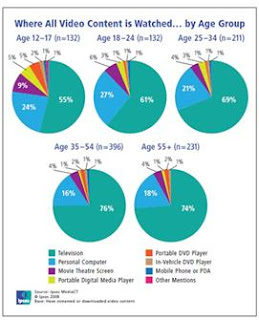 percentage of video watching on TV had gone down from 75% to 70% from 2007 to 2008. This chart gives a lot more detail on the devices used. When you look at it carefully, there’s something really interesting. As you would expect, TV watching is lowest in the younger age groups, but the trend is not linear. Look at the “portable DVD players.” It’s much higher among the very young (too young to pay for one themselves), lowest among the two middle age cohorts, and higher among the two oldest. Is this an affordability issue among the 18 – 34s, who are the lightest users? Or is it a preference? Marketers beware of extrapolating trends!
percentage of video watching on TV had gone down from 75% to 70% from 2007 to 2008. This chart gives a lot more detail on the devices used. When you look at it carefully, there’s something really interesting. As you would expect, TV watching is lowest in the younger age groups, but the trend is not linear. Look at the “portable DVD players.” It’s much higher among the very young (too young to pay for one themselves), lowest among the two middle age cohorts, and higher among the two oldest. Is this an affordability issue among the 18 – 34s, who are the lightest users? Or is it a preference? Marketers beware of extrapolating trends!
With that warning in mind, here are some related factoids from two recent Pew studies:
From a telephone survey in December 2007:
• 48% of internet users said they had ever visited a video-sharing site such as YouTube. A year ago, in December 2006, 33% of internet users said they had ever visited such sites. That represents growth of more than 45% year-to-year.
• 15% of respondents said they had used a video-sharing site "yesterday" -- the day before they were contacted for our survey. A year ago, 8% had visited such a site "yesterday." Thus, on an average day, the number of users of video sites nearly doubled from the end of 2006 to the end of 2007.
A later release from the same survey revealed that 62% of respondents had accessed the Internet or data from a mobile device:
• 58% of adult Americans have used a cell phone or personal digital assistant (PDA) to do at least one of ten mobile non-voice data activities, such as texting, emailing, taking a picture, looking for maps or directions, or recording video.
• 41% of adult Americans have logged onto the internet on the go, that is, away from home or work either with a wireless laptop connection or a handheld device.
According to John B. Horrigan, Associate Director of the Pew Internet Project and author of the report “People’s growing reliance on their cell phones, together with wireless internet access from laptops, suggests a shift in expectations about cyberspace. For many people, access to digital information and resources is an ‘always present’ utility for answering questions and documenting what is going on around them through photos or video recording.”
Marketers should remember that age matters when deciding how to provide content for mobile users, but it may not matter in easily predictable ways. It’s important to find out how your own target audience wants their content and on what device. You can assume they want it when they want it!
Monday, June 30, 2008
Ubiquity of Content--Users' Perspectives
Posted by MaryLou Roberts at 11:42 AM 0 comments
Labels: mobile, segments, social media, user control, video
Thursday, June 26, 2008
Ubiquity of Content--Producers' Perspective
Your attention may also have been caught, as mine was, by a headline in AdAge MediaWorks (subscription required) a few days ago; “Consumers to Watch 25% More Video a Day in Five Years: Viewing on Computers, Mobile Phones Will Drive Increase.” We all know that video has become an indispensible part of the Internet landscape. This incredible rate of growth has implications beyond video itself to all types of content.
Users expect content to be “any time, anywhere, on any device” more than ever before. And that’s putting strain on marketers to meet their demands in ways that advance marketing objectives. A recent study of media and entertainment executives by Accenture sheds more light on the issue. Their results point to the importance of multi-platform distribution, an open model of content sharing, the importance of digital royalty (revenue) management and a common understanding of intellectual property. 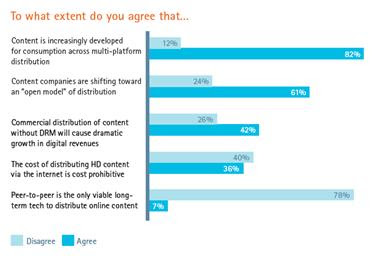
The concept of an open model of content distribution deserves attention. It’s an enterprise concept, not free provision of content. According to a 2006 white paper by PricewaterhouseCoopers, “in order to create shareholder value, companies in the content, technology, and distribution sectors must adopt an open business model, eliminating internal walls between business units and external ones between the company, its partners, and other strategic business allies.” This clearly refers to the creators of content who have already begun to distribute content to users through various channels. To better understand the strategic implications for enterprises, the entire 62-page PWC report is worth reading.
Consider these charts from Compete on two major content creators for TV--NBC and Fox--and the growing share of some of their programming on video-streaming site Hulu. Interesting, isn’t it, that the share of comedy viewing on the Internet is considerably greater than for dramatic programs. Wonder what that implies? Demographic differences, certainly, but probably more.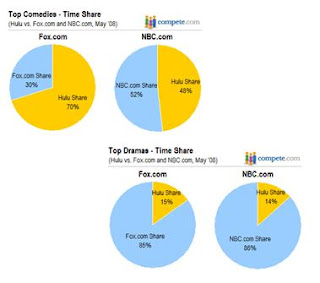
The Accenture study suggests capabilities that are necessary to accomplish media convergence within the enterprise. The point
convergence within the enterprise. The point
being that unless the internal barriers can be broken down, the “anywhere, any time, any device” needs of the user cannot be met. The content companies in the Accenture study believe they have organizational capabilities in place to meet those needs. How many product or service companies can say that they have organization-wide understanding of intellectual property rights, the necessary IT architecture, integrated management of their digital assets, the necessary customer data and insight and a way to track the revenue produced by their content? Accenture believes that content companies are not as far along as many believe they are in this difficult organizational transformation. I’d suggest that even fewer product/service companies are dealing with issues of how to use content to best advantage.
I’ll conclude this segment with a quote from a US media executive in the Accenture report:
“You must break the innovators dilemma and walk away from old paradigms…you must have a keen focus on determining what consumers really need and what makes their lives better.”
I’ll continue with an installment on what consumers really do want.
Read Part 2 here.
Posted by MaryLou Roberts at 11:48 AM 0 comments
Labels: content, convergence, Hulu, marketing organization for new media, new media, video
Wednesday, June 25, 2008
Best Practices B2B Site
I recently saw a mention of Mfg.com, and since I’m fascinated by B2B marketplace sites, I took a look. Founded in 2000, it seems to be profitable and recently obtained another round of venture funding. It is commonly described as an exchange for parts and components, but they describe their model as a proprietary platform that facilitates “the complex process of sourcing and selling manufacturing services”. They recently revamped their platform to make it easy for buyers and sellers to share CAD designs to speed the sourcing process, so they are clearly a sophisticated user of technology.

What I found was also a best practices site for B2B community building. They have numerous industry-based communities, a system of news feeds in which a member can subscribe in various ways including content channels and tags, and various blogs. They offer blogging to their members and have a company blog. When I investigated the profile of frequent poster aj, I met Mfg.com’s Director of Community Content. His profile page included his other blogs, his most-used tags, and other members with profiles similar to his. Great personalization and networking! They also recognize Top Contributors on the community home page, which is another nice touch.
The site says it helps customers:
Find content. The site is content-rich and uses tags as well as content channels (the site calls them “spaces”) to organize it. There are various search options. They have a sophisticated system of RSS feeds that allows people to subscribe in various ways including tags. They also have email notification, which seems more limited in scope. They are pushing RSS, which is interesting, given how full our email inboxes are these days.
Create content. Members are asked to create profiles. They can comment on blog posts, ask questions, and receive feedback. The other content creation mechanisms are wiki-based, allowing for various types of documents that can be shared with open or closed groups. The documents allow for many types of review and comparison.
Collaborate on content. Creating wiki-based documents on the site draws colleagues of the members (who then have to become members) to collaborate on documents. And since the site is content-rich, that offers the likelihood of the new member starting the cycle all over again.
Take a close look at those three steps—find, create, collaborate. That’s social media strategy in a nutshell. Content to draw people to the site, social connectivity to increase the usefulness of the content, and collaboration to allow members to work right on the site and bring others with them. When members are not on the site, RSS feeds remind them of the value it offers to them.
This is best practices in terms of strategy as well as execution!
Posted by MaryLou Roberts at 9:11 AM 0 comments
Labels: B2B, blogs, business models, community, customer acquisition, customer retention, social media, wikis
Tuesday, June 24, 2008
Seniors Go Social
We’ve already established that seniors read and publish blogs. Now a new study by the AARP and Center for the Digital Future finds that seniors are increasingly social on the web. Here’s a summary of findings, primarily comparing respondents over 50 to those under 50.
They are more active in some ways:
•They are more likely to check the web for news—at least once a day, sometimes several times a day.
•Those who are members of online communities are more likely to log onto their community sites at least once a day.
•They are more likely to engage in social activism as a result of participation in online communities.
•They are more likely to play online games.
They are equally likely to engage in certain activities or have certain Internet-related attitudes:
•They are equally likely to research products online before purchasing offline.
•They are equally likely to feel the importance of using the Internet to maintain social relationships.
•They are equally likely to say that their online communities are important.
Younger users, especially those under 20, are still dependent on the Internet for content and communications tools:
•Younger users are more likely to say that the Internet is an important source of information, but the number of respondents who agree with this statement has grown since 2002.
•Younger users are more likely to use instant messaging and to download videos.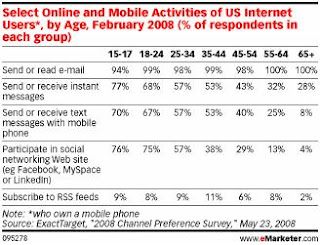
This table from eMarketer (June 10, 2008) presents comparable data from another recent study. No one is surprised by the fact that younger users to more of virtually all the activities or that email is ubiquitous. Try reading across the rows from right to left. It’s also not a surprise that the frequency of use grows as you move down the age cohorts. Is is a surprise how much the activities increase and how active the 45 to 54 age group is?
AARP has long been a huge user of direct mail for membership acquisition. Their bi-monthly magazine has long enjoyed the highest circulation of any magazine. It helps to maintain that dominance with age-based publications;
Rate Base: 23.5 million
50s edition: 7.6 million
60s edition: 7.5 million
70s edition: 8.4 million
AARP has not let the Internet grass grow under its feet, however. In April they relaunched their website with a greater focus on interactivity and social connectivity. One aspect was the establishment of Bulletin Today page. To better understand the AARP perspective on seniors, note that they offer a RSS headline feed as well as email subscriptions to their weekly newsletter.
relaunched their website with a greater focus on interactivity and social connectivity. One aspect was the establishment of Bulletin Today page. To better understand the AARP perspective on seniors, note that they offer a RSS headline feed as well as email subscriptions to their weekly newsletter.
I registered for the Bulletin page to see what was going on. They immediately  established my personal page and sent me to the profile page. They even offered me help in filling it out! Way cool! When they sent an email confirmation, it stressed that “you'll find exciting new ways to get involved, express yourself, and connect with others.” They keep reinforcing the connectivity message. Even cooler!
established my personal page and sent me to the profile page. They even offered me help in filling it out! Way cool! When they sent an email confirmation, it stressed that “you'll find exciting new ways to get involved, express yourself, and connect with others.” They keep reinforcing the connectivity message. Even cooler!
As far as I can tell, it’s a success. According to Kevin Donnellan, Executive Vice President and Chief Communications Officer, “Our Web site, aarp.org, is experiencing steady growth among people 50+. Not only are they visiting our site for information, but they are also using our social networking, gaming, and news channels in ever-increasing numbers as this study confirms.”
Seniors are online. They are connecting with content and people there. Marketers who understand the needs of this cohort—growing not only in numbers but in technological sophistication—can indeed connect with them online.
Posted by MaryLou Roberts at 11:06 AM 3 comments
Labels: segments, social media, social media strategy, social networks
Wednesday, June 18, 2008
Harrah's Adopts Surface Computing
I’ve written about Microsoft’s surface computer before. It offers lots of opportunities for entertainment and interaction but it’s still pricey at $10,000 per unit. Also, I’ve long been fascinated by Harrah’s and their incredibly comprehensive and successful loyalty card program.
When I saw the article in CNET about Harrah’s installation of six surface computers in a bar in one of its Las Vegas casinos I read it with interest. The computers offer bar patrons a variety of applications—they can develop their own mixed drinks and send them to other patrons, watch YouTube videos, play games, and use an app called Flirt. You can see the uses on this seriously lame promotional video from Microsoft. I’m having trouble deciding whether the women or the men are most insulted by the content, but it does show the tables in action. View the video here.
View the video here.
The implications are broader than just empty-headed beautiful people flirting in a bar. Harrah’s has long been famous for its Total Rewards program and the way they  use the resulting database to market their individual casino locations. If you know this story, your first thought is, “Data; I wonder what use they are going to make of it?” A lot of their marketing is based on knowing what individual customers do in specific casinos and marketing to their interests and needs. The surface computers are meant to fit into their databased marketing program in some way. I can’t see anything very profound from the features they currently offer, but it may be only a first step.
use the resulting database to market their individual casino locations. If you know this story, your first thought is, “Data; I wonder what use they are going to make of it?” A lot of their marketing is based on knowing what individual customers do in specific casinos and marketing to their interests and needs. The surface computers are meant to fit into their databased marketing program in some way. I can’t see anything very profound from the features they currently offer, but it may be only a first step.
If you don’t know the Harrah’s story, it’s an excellent example of disciplined database marketing. If you have access to the Harvard Business Review there have been several articles by and interviews with CEO Gary Loveman since he took over in January 2003. There is a recent interview on The CEO Show with Robert Reiss. The 18-minute audio interview focuses on customer service but the importance of data about customers and how they use it at Harrah’s is frequently emphasized in the discussion. To listen, follow this link and scroll down to the March 9, 2008 interview. It’s worth it.
The Total Rewards program is deservedly famous. Take a look at its tiered strategy, which has emerged from segmentation analyses over the years. Harrah’s SVP of Relationship Marketing, David Norton, says it’s more than just a rewards program. Another way of saying that is that Harrah’s captures, mines and develops and executes marketing programs based on the customer data they capture from the program. That applies to individual customers and individual casino locations. In 2005 Norton said that 50% of Harrah’s revenue was driven by [targeted] marketing. That’s a major achievement, especially in an industry where glamorous properties, big-name entertainment and marquee chefs are the essence of strategy.
It’s about both data that drives programs and people who execute them. Gary Loveman has understood that from the beginning. It doesn’t happen overnight, but once a company puts a disciplined databased marketing program into place, it just gets better over time.
The Internet is now a chief source of data about our customers. How many of us capture and use transaction and activity data well? How many develop customer-effective programs that provide more of the kind of data we need to serve those customers better and win their undying loyalty? Very few!
Posted by MaryLou Roberts at 12:14 PM 0 comments
Labels: CRM, customer service, database marketing, interactive marketing
Tuesday, June 17, 2008
Of Blog Spam and Twingley
The IAB Smart Brief (June 13) recently referenced an article on a new blog search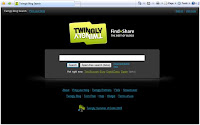 engine with the improbable name of Twingly. I took a look at this Swedish site and found its content and business model interesting in several respects.
engine with the improbable name of Twingly. I took a look at this Swedish site and found its content and business model interesting in several respects.
Of course I searched for this blog and was pleased to find it there. Not all posts were listed, so I pinged it to try to get the entire blog indexed and available for listing with their partner sites (one way they monetize), which are mostly content sites. So far so good! The link to the blog took me to the most recent post, which was fine. Then I clicked on the profile, expecting to find my own profile. Instead, I found a profile of the blog itself, which was interesting. There was some activity of which I wasn’t aware. That surprised me because I think I watch it carefully.
was fine. Then I clicked on the profile, expecting to find my own profile. Instead, I found a profile of the blog itself, which was interesting. There was some activity of which I wasn’t aware. That surprised me because I think I watch it carefully.
But I was most interested in the concept of spam-free blog search. This blog doesn’t show up when I search using the spam-free function, so I clearly have some more work to do. First, I needed to read up on blog spam. These are some of the basic types:
•Comment spam, in which a comment links to a totally unrelated, often malicious, site
•Comment spam flooding, in which a robot leaves so many spam comments that the server may crash
•Trackback spam, in which spammers take advantage of the trackback function which is supposed to report that another site has linked to your post
•Referral spam, in which spammer basically creates invalid links.
There are a variety of reasons for these activities, for example to get links thereby increasing visibility, to acquire visitors with the hope of capturing data or placing malware of some kind, or to increase traffic and therefore ad rates. There are probably others, but you get the idea. Wikipedia has an extensive discussion. A blog called The Spam Diaries deals exclusively with the topic of spam.
There are some important take-aways from this in addition to the attractive idea of finding out (on Twingly) that certain blogs are spam free. Just be a bit cautious because not all valid blogs are listed there. Active bloggers need to use the basic protections like CAPTCHA verification and moderation for comments. They also need to use common sense. I had several comments earlier in the year that purported to be offering advertising opportunities. A quick web search for the site from which it said it came (the relationship wasn't obvious) revealed that other bloggers though it was an attempt to place malware of some type. Flush that one!
If you’re thinking of starting a blog, the protections offered by the blogging platform are something you might want to consider. All the major platforms have their own blog and have discussed this subject extensively. My reading suggests that basic comment protection is much the same on all the platforms but they have different solutions for the more esoteric types of blog spam.
This all started with Twingley, which has an interesting business model. Not only do they offer content for sites that want feeds, they say they are developing “kick-ass products” based on the knowledge they acquire. So far they have the Twingley Blogstream widget, apparently the way they supply content to traditional media. They also have the Twingley Screensaver, which they say monitors the state of the blogosphere in real time.
A site to keep an eye on!
Posted by MaryLou Roberts at 10:23 AM 0 comments
Labels: blogs, business models, spam
Monday, June 16, 2008
The Internet is Changing Politics Too
As if we didn’t already have enough to content with, politics is undergoing change as a result of the Internet. Facebook is one aspect, but not the only one. View the video here.
View the video here.
In case you missed this video focusing on the presidential campaign on Ad Age last week, you should take a look. It features some major moments of televised political campaigns while focusing on the changes that have taken place just since the last national election. The changes are major and they are leading to a different kind and level of political participation, at least for some segments of the voting population.
Over the weekend Pew released a study of the impact of the Internet on the campaign (get the full report here). There are few surprises, except perhaps the magnitude of the trends. A quote from ClickZ captures the essence of the summary data in the chart:
"What this report confirms in the particular case of politics is that the electoral world is moving in the same direction as the broader Internet world," said Pew Internet & American Life Project Director Lee Rainie. "Everything we are picking up for politics is playing out in the commercial and non-commercial space online in the same ways."
We probably shouldn’t be surprised at that, but in spite of the use all the candidates have made of the Internet, the campaigns may still be underplaying its importance. Michael Bassik, VP of interactive marketing at MSHC Partners said in ClickZ that the percentage of campaign advertising budgets allocated to the Internet has not changed since the last national campaign in 2004.
"When you look at the fact that nearly half of all adults got information about the primary through new media and compare that with fact that the candidates collectively spent less than 2 percent of their ad budgets to advertise on the Internet, clearly there is a tremendous disconnect between the amount of information people want to receive from the Internet and the amount of information candidates deliver to these audiences," said Bassik.
Sounds familiar, doesn’t it? The dollars aren’t yet following the audience—in politics just as in brand marketing. It’s an imbalance that will be remedied over time, but some brands, perhaps some candidates, will lose out by being too slow to grasp the magnitude of the shift.
Posted by MaryLou Roberts at 11:50 AM 0 comments
Labels: marketer response to social media, online advertising, political marketing, social media, social networks
Wednesday, June 11, 2008
Social Networks and Travel Planning
With another summer weekend approaching, it seems a good time to think about travel.  It’s pretty much accepted that the booking of travel has seen a huge shift to the web. When I ask my students they look at me like “is there any other way?” Penetration is not complete, however, as this recent chart from eMarketer (newsletter, June 3, 2008) shows. The Internet is a huge factor, whether or not travel is booked online. Describing results from a study of American families conducted by AOL the newsletter says that, “Almost three-quarters said they used the Internet for vacation planning. Of these Web-savvy consumers, 72% browsed search engines, 58% went to online booking sites, 26% visited consumer testimonial sites and 19% browsed travel information sites.” The web is clearly an important source for these family vacationers, and they are consulting user-generated content as well as travel industry content.
It’s pretty much accepted that the booking of travel has seen a huge shift to the web. When I ask my students they look at me like “is there any other way?” Penetration is not complete, however, as this recent chart from eMarketer (newsletter, June 3, 2008) shows. The Internet is a huge factor, whether or not travel is booked online. Describing results from a study of American families conducted by AOL the newsletter says that, “Almost three-quarters said they used the Internet for vacation planning. Of these Web-savvy consumers, 72% browsed search engines, 58% went to online booking sites, 26% visited consumer testimonial sites and 19% browsed travel information sites.” The web is clearly an important source for these family vacationers, and they are consulting user-generated content as well as travel industry content.
The social aspects of this reminded me of a site a friend brought to my attention when she was planning a business trip several weeks ago. Dopplr is a Finnish site; I was especially interested in the fact that the invitation was delivered by LinkedIn. When I investigated the site, I found that the site allows travelers to share itineries with contacts from Gmail and Facebook, and perhaps others—as well as from LinkedIn. Or you can invite people and create your own network on Dopplr (names in the graphic are not real names).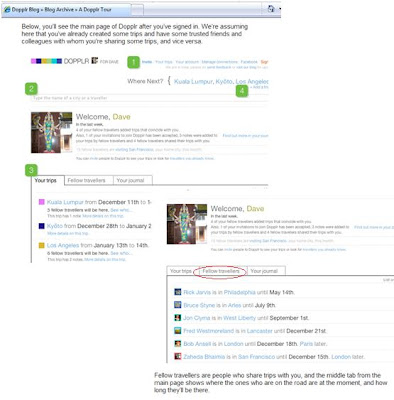 So this is clearly cool. Most of us have dined alone or attended a concert by ourselves in a strange city, so this is attractive. Whether it’s worth the effort is another question. My guess is that it is not unless you are extremely social or—more likely—a frequent traveler. It’s also nice to see who is going to be in your own city also in case you want to do some networking.
So this is clearly cool. Most of us have dined alone or attended a concert by ourselves in a strange city, so this is attractive. Whether it’s worth the effort is another question. My guess is that it is not unless you are extremely social or—more likely—a frequent traveler. It’s also nice to see who is going to be in your own city also in case you want to do some networking.
But something else occurred to me. A few companies have pages on LinkedIn; not long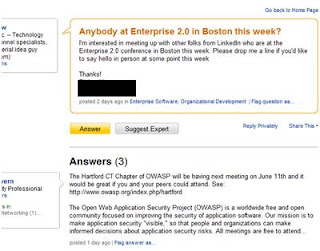 ago I wrote about Basho and their LinkedIn Group. It seemed like a cool idea to network B2B customers, but I couldn’t see that there was a lot going on. LinkedIn makes it possible to ask a question to find if contacts are going to be, say, at an upcoming conference. It clearly works but doesn’t seem terribly efficient. Among other things, it seems to depend on people checking their LinkedIn messages. I wonder how many others don’t do that very often.
ago I wrote about Basho and their LinkedIn Group. It seemed like a cool idea to network B2B customers, but I couldn’t see that there was a lot going on. LinkedIn makes it possible to ask a question to find if contacts are going to be, say, at an upcoming conference. It clearly works but doesn’t seem terribly efficient. Among other things, it seems to depend on people checking their LinkedIn messages. I wonder how many others don’t do that very often.
I’m not sure exactly how to do it, but if a B2B firm or trade organization could use the Dopplr technology to allow people to network at conferences, that seems to be a useful addition to conference services. That would seem to be an idea whose time has come, and Dopplr appears to have the technology to do it!
Posted by MaryLou Roberts at 12:13 PM 2 comments
Labels: B2B, LinkedIn, social networks, travel, user generated content
Tuesday, June 10, 2008
Google Gadgets and White-Label Widgets
It’s no secret that I’m a fan of widgits. They offer useful content and functions. Even more important, they are completely controlled by the user and improve the web experience instead of interrupting and degrading it.
So last week when this video floated into my inbox, I took the time to watch it. It was filmed at the Google Developers conference and the quality reflects that. The content is well worth the 4.5 minutes it takes; it ranges from the new Gmail widget (available only for iGoogle pages at the moment), to a Google Maps applications that lets you follow a soapbox derby down city streets, to an app that lets you control the way you embed videos into blogs and web pages.
Most of these are entirely DIY; the YouTube video embed may require some knowledge of JavaScript. That means, for most of us marketers, that it may require a developer to install. That’s doable; the question we should ask is will we be able to maintain it without undue difficulty once the developer is finished? The answer is “probably yes,” but it’s a question that needs asking. If the freebies don’t work, you can get rid of them as easily as you acquired them; most of us want to exercise care when we actually spend money on these things. Do you have an iGoogle page—or any other personalized page (if you have Gmail, I think you automatically have an iGoogle page; you just may never have used it)? I’m surprised how many people don’t. It’s a useful experience to see how some of their widget collection works. Some is useful content—notice that weather is the first listed. Others provide an often-used function—I saw both a calendar and a
Do you have an iGoogle page—or any other personalized page (if you have Gmail, I think you automatically have an iGoogle page; you just may never have used it)? I’m surprised how many people don’t. It’s a useful experience to see how some of their widget collection works. Some is useful content—notice that weather is the first listed. Others provide an often-used function—I saw both a calendar and a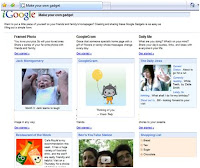 calculator. Some are just plain fun—I loved the Yoda-speak gadget. Note the comments and that the developer is responding to his users. Don’t find one you like? Create your own from easy-to-use templates! The downside is that these are only for iGoogle pages, at least at this point.
calculator. Some are just plain fun—I loved the Yoda-speak gadget. Note the comments and that the developer is responding to his users. Don’t find one you like? Create your own from easy-to-use templates! The downside is that these are only for iGoogle pages, at least at this point.
There are alternatives—the so-called white label widget (or, more generally, marketing services) providers. TechCrunch defines the concept in terms of a social network; it applies equally to the creation and deployment of widgets. “The idea of white labeling a network is to make the platform provider as invisible as possible to the social network’s users and to brand the network with the builder’s identity or intent.” According to today’s Media Post one of the white-label widget makers, KickApps, is partnering with Clearspring Technologies to allow marketers to distribute their widgets through its network and track their use.
Whether you want a Google Gadget or you want to create your own branded widget from scratch (note the National Geographic widget in the Google list), there are platforms and services to meet your needs. Become an avid user of widgets and use your experience to think about how you can use them to provide branded content to your target audience. It’s content they have chosen and are likely to pay attention to. Can we say that about most advertising?
Posted by MaryLou Roberts at 11:02 AM 1 comments
Labels: diy, Google Gadgets, internet marketing, social media, web 2.0, widgets
Monday, June 9, 2008
Visiting NASA in Second Life
One of my summer resolutions was to learn to get around in Second Life so I can see what’s going on. So when I saw that NASA had developed a cybertwin for its Phoenix rover, I gritted my teach and took a shot at it.
Fair warning; when you register you have to complete a four-step tutorial in order to get the bare basics of how to function in Second Life. It’s a bit annoying, especially if you’re too impatient to read the directions and have to keep going back. But once you complete four basic steps you have the key to Second Life and you can move around.
Still ignoring the directions as much as possible I searched for the NASA island and after a couple of failed tries (maybe I should have taken some of the advanced tutorials!) I teleported to the Nasa Explorer Island.
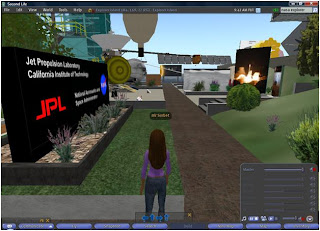
Here I am—or at least here my avatar is. There’s nice music playing; sounds like something from 2001: A Space Odyssey. I walked around the island and saw the main Jet Propulsion Laboratory Building and the Media amphitheatre. I wasn’t there when there was an event going on, but there’s stuff to do. I was going to try to launch Mars airbag, but I never found the mountain. There are also scheduled events—launches and demonstrations.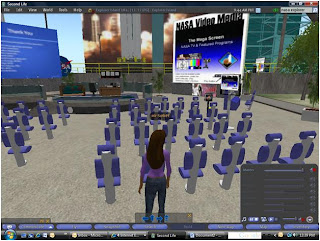
For those of you who don’t want to spend several hours figuring out how it all works, there’s a video on the site of MyCyberTwin, the developer of the “twin” (avatar?) of the Phoenix rover. It’s fun, but since it works off a knowledge base, it doesn’t seem to have a large repertoire. (View video here.)
It’s interesting and sort of fun. I plan to continue my explorations and report on them. But it also highlights the problem for most marketers. Do they have several hours to learn how to use something like Second Life, just because they want to see something in particular that’s going on?
Probably that’s not high on their priority list. Many of them could ask their teenage (or younger!) children who will be able to give them a tour, maybe not of Second Life, but of a virtual world that’s more age-appropriate. But some are just going to have to invest the time to understand what their target audiences are doing and how they can participate and create engaging events/activities/locations. Maybe a worthwhile summer activity for a lot of us!
Posted by MaryLou Roberts at 1:45 PM 0 comments
Labels: interactive marketing, virtual worlds, web 2.0
Thursday, June 5, 2008
Local Media-Global and Close to Home
 Borrell Associates recently released its 2008 survey of local media. The two largest shares go to pureplays (57%) and newspapers (25%). According to Borrell’s 2007 survey newspaper had a share of 40%, “but pure-play internet companies (Google, Yahoo!,Monster et al.) are hot on their heels, with 33.2 percent.” Right on both counts! I wonder if anyone anticipated the rapidity of the shift (download both 2008 and 2007 here).
Borrell Associates recently released its 2008 survey of local media. The two largest shares go to pureplays (57%) and newspapers (25%). According to Borrell’s 2007 survey newspaper had a share of 40%, “but pure-play internet companies (Google, Yahoo!,Monster et al.) are hot on their heels, with 33.2 percent.” Right on both counts! I wonder if anyone anticipated the rapidity of the shift (download both 2008 and 2007 here).
It is happening globally, in case you have any doubt. Yesterday’s MarketingCharts featured a report from the World Association of Newspapers that shows a remarkable move to digital media. As I read the chart, it also shows a large increase in the time people are spending with media overall, which should bode well for an informed population. TV’s global share of advertising dollars is pretty stable, but newspaper’s continues to decline. According to the report, though, “Despite the slowdown of global print advertising spending, print remains the second most popular advertising medium, and by far claims the lion's share of spending over digital media” (download the executive summary here). For the time being anyway.
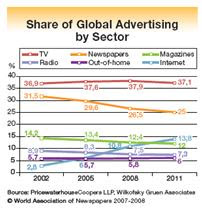
Put those data against a recent article in the WSJ (subscription required) about the struggling “hyperlocal” site LoudounExtra.com, a product of the Washington Post that focuses on a single Virginia county. I took a look at it, and have some observations.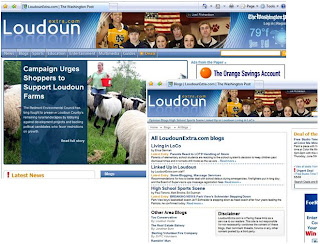
It’s certainly focused. There’s a link to the Washington Post home page, but the content is exclusively from Loudoun county. And it’s pretty exclusively news—take a look at the main nav bar if you don’t have time to visit the site itself. All the articles in all the sections except Deals (where it doesn’t make sense) have a comment function. There are very few comments; that shows on the individual articles and on their “Most Commented” tab on the home page.
I took a look at the blogs page, because that seems the obvious place for a lot of interaction. There are many personal blogs about the local community linked here, but they don’t seem terribly active either.
The site seems to be doing all the right things—except maybe one. There are ads and listings but no ability to make comments about specific businesses or venues. For instance, on the Museums and Historic Sites you can submit a comment on that page, but I can’t find a way to submit a comment or to rate my visit to Mount Vernon, one of the sites listed. That seems to be one of the more popular activities on other local sites, and I can see why a newspaper site might not want to take a chance on offending advertisers. I also can’t find an opportunity to upload photos of my visit to Mount Vernon, and that’s another popular activity on local sites.
So not only is this site perhaps too focused on a specific local area, I’d suggest it’s too focused on news and not enough on user interaction. My sentiments only, but it’s an interesting hypothesis. For whatever reason, this doesn’t seem to be the business model as print newspapers work to expand their digital franchise.
Any other examples of local sites, successful or otherwise, and insights about the reasons?
Posted by MaryLou Roberts at 1:15 PM 0 comments
Labels: blogs, business models, global, global internet marketing, local media, online advertising, user generated content
Wednesday, June 4, 2008
Social Media Data--Free?
Social metrics service Sometrics launched in beta last fall and was opened to  developers in March. The stated purpose was to allow developers to track the performance of their apps on selected social networks. The new firm received venture funding in May amid questions about the viability of their business model. This is what they said in an early press release:
developers in March. The stated purpose was to allow developers to track the performance of their apps on selected social networks. The new firm received venture funding in May amid questions about the viability of their business model. This is what they said in an early press release:
The Sometrics analytics solution will always be free and we'll never share or make your data public without consent. As FB developers ourselves, we understand that privacy is a major concern. Therefore, Sometrics doesn't collect any personal data such as names, contact info, etc. and all aggregate metric data (gender, age, etc.) cannot be linked back to an individual.
The question about how they intend to monetize the service became clear today. They’ve launched an ad-serving network and say they hope to raise the CPMs from ads placed on social media sites. CPMs overall have been going down. PubMatic, another relatively new firm, provides free data—do we see a trend here?
The downward trend is pretty obvious. They add:
•On average, Web site monetization dropped by 23 percent from 49 cents in March to 38 cents in April.
•Among the verticals, Social Networking led the plunge with monetization dropping 47 percent, from 37 cents in March to 19 cents in April, below January lows of 22 cents. Entertainment monetization dropped 17 percent from 40 cents in March to 33 cents in April. Gaming and Sports were down marginally (4 percent and 5 percent, respectively). Technology remained relatively flat at 83 cents in April vs. 82 cents in March, but is still off January highs of 92 cents.
•In April 2008, 77 percent of Small Web sites garnered net publisher eCPMs from ad networks of under $1.00, compared with 95 percent of Medium Web sites and 100 percent of large web sites.
•Across all Web sites, the range of eCPMs was $0.002 to $18.45.
Their AdPriceIndex is free and looks as if it’s going to be worth watching. How do they do it? Their business is optimizing ads for publishers and they collect data from those activities to construct an index of ad network pricing. It’s not representative of all advertisers (the data presently comes from 3,000 publishers), but it’s instructive—and previously hard to find.
Back to Sometrics. Media Post says:
By virtue of its social hyper-targeting, Sometrics expects to be able to deliver CPMs of $1 to $2 for application-based ads, which typically command rates of 10 cents to 80 cents today. The company's system could also be used to serve premium and remnant display advertising on social networks.
Comparing that with the PubMatic stats, $1 to $2 would be highly attractive—if they can pull it off. Marketers have not been entirely satisfied with advertising forays on social networks (subscription required). An article in Ad Age earlier in the week says some high-profile campaigns on social network have total media spend approaching $25,000 per viewer film submission. That’s not advertising per se, but it’s a really high acquisition cost! In terms of CPM itself, a post on the Inside Facebook blog quotes reader/advertiser CPMs from over $4 (grain of salt) to 4 cents. The post drew interesting comments with more reader submitted CPMs. But you get the idea.
Several things are going on here:
Business models: New marketing services firms in this space are providing paid services and generating free data about the space, presumably with the full knowledge of their customers. Is that good for the growth of social media as a marketer communications channel? Assuming the data is valid, absolutely! Reliable data is one of the missing components in this space.
Cheap inventory on social networks: We’ve probably all read statements to that effect. These data appear to confirm that. They may also support the assertion that cheap inventory on social media sites is driving down CPMs across the web.
Ad targeting and tracking: Advertisers have been looking for opportunities that really work in social media and it seems evident that careful targeting is part of that equation. Tracking is essential to know what is working. What strikes me on several of these sites/posts is that they are talking about developers tracking the success of the apps they write for social sites. Where are marketers? These are our emerging channels; are marketers deeply involved in these programs? I hope so!
The beat goes on, with no end in sight to developments in the social media space. Data that helps us understand trends is welcome—especially when it’s free!
Posted by MaryLou Roberts at 11:26 AM 0 comments
Labels: business models, internet marketing, online advertising, social media metrics, social media strategy, social networks
Tuesday, June 3, 2008
Social Banner Ads?
This morning’s Media Post reports on a keynote speech at the IAB Social Media Conference by Seth Goldstein, CEO of Social Media Networks. His agency is preparing to introduce a new type of “social banner” ad format, so he is not unbiased. That doesn’t make what he says less relevant.
"Social media is killing advertising," Goldstein said. "A few years ago people started to become more interested in each other [online] and less interested in advertising." With response rates for standard banner ads under 1% and search not geared to brand advertising, social media is the next frontier for major marketers to attack.
Even Google admits that its deal to serve ads on MySpace “is not monetizing as well as we had expected.”
In his talk Goldstein mentions advertising for the BMW Series 1, which I’ve mentioned before. I looked around to see what was going on specifically on Facebook and this is what I found; a contest on the Facebook Graffiti Wall app. The shot of the top looks pretty much like other contests we’ve seen, particularly in that viewers can not only participate (note that participation is directly on Facebook) but they can also vote on the winners. The bottom half shows product information that’s part of the page. According to what’s on the page the contest (now over) drew 9006 entries and 2143 fans who presumably followed it closely. Ok, so you’ve looked at the top of the page and you see entries by 2 highschoolers. What good does that do BMW (think tomorrow vs. today when answering that one)?
I looked further to see how much I could find about the entrants. You can see the Top 150 and the Winners. Do take a look—a screen shot just can’t do these justice! If you click through on the names of some of those who placed highest, you find that you can’t see their full profiles unless you “friend” them (which requires their permission if you aren’t a denizen of Facebook). So there’s a vote here for a modicum of privacy among these young adults. And from their pictures, it’s obvious that the winners and top entrants are young adults, not teenagers messing around. Young adults, remember, is the target market for the BMW Series 1. Is this a digression? Maybe not. I found a hint about what social banner ads might look like on Goldstein’s corporate blog. He describes the evolution of online advertising as being, first, display then behavioral with social on the horizon. I know you can’t read what’s on that section; I had to blow it up so much I couldn’t copy it, but here’s what it says:
Is this a digression? Maybe not. I found a hint about what social banner ads might look like on Goldstein’s corporate blog. He describes the evolution of online advertising as being, first, display then behavioral with social on the horizon. I know you can’t read what’s on that section; I had to blow it up so much I couldn’t copy it, but here’s what it says:
•“Where do you want to take a test drive?”
•“Have you seen Indiana Jones yet?”
•“Have you heard the new Goldplay (?) CD yet?”
You get the idea, especially once a social banner is on a targeted site. Where do you want to test drive (virtual or real?) the BMW? Let’s talk movies. Let’s talk about some band (that I’ve never heard of, so don’t target me!).
Engage people in a subject that interests them and begin a dialog with interested prospects. That’s the theme song of social media! Here are a couple of interesting ways to think about doing just that!
Posted by MaryLou Roberts at 10:18 AM 0 comments
Labels: APIs, customer conversion, interactive advertising, online advertising, social media, social media strategy
Monday, June 2, 2008
What Do Consumers Want from Mobile?
A few weeks ago I made a post on a mobile service that caught the attention of Sachendra Yadav, a product manager in the Indian telecommunications industry. He posted a reply on his very interesting technology blog, “What I Want from My Mobile Social Network.” If you missed his comment and the link, it’s a formidable list that is well worth considering.
We all know that the US is well behind on the mobile curve and can look to mobile services in other countries for insight. Two recent studies are helpful.
Accenture uses Forrester data to point out that “there is currently a huge gap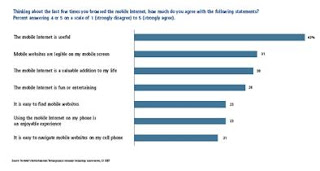 between what users would like to do on the mobile Internet and what they actually can do” (page 4; download the full study here). Sachendra is apparently not alone! Most respondents in the Forrester survey don’t find the mobile Internet very useful or easy to use.
between what users would like to do on the mobile Internet and what they actually can do” (page 4; download the full study here). Sachendra is apparently not alone! Most respondents in the Forrester survey don’t find the mobile Internet very useful or easy to use.
Another 2008 study, this from the IBM Institute for Business Value, concentrates on strategy for MDMs (mobile device makers; download the full study here). In the process it gives some interesting data from a survey of about 700 consumers in the US, Japan, India, China and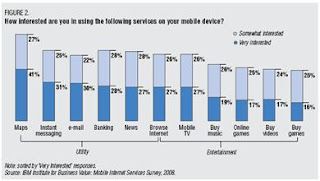 Germany. They didn’t include South Korea, another advanced mobile economy which should be watched. These consumers want many services from maps to games. The chart divides the services up between Utilities and Entertainment—interesting. Note that browsing the Internet sits squarely on IBM’s dividing line between the two. Note also that if you combine “very interested” and “somewhat interested” a majority of their respondents are interested in the services from maps, most desired, to mobile TV, desired by just over half the respondents. That represents a large opportunity for providers of both services and content.
Germany. They didn’t include South Korea, another advanced mobile economy which should be watched. These consumers want many services from maps to games. The chart divides the services up between Utilities and Entertainment—interesting. Note that browsing the Internet sits squarely on IBM’s dividing line between the two. Note also that if you combine “very interested” and “somewhat interested” a majority of their respondents are interested in the services from maps, most desired, to mobile TV, desired by just over half the respondents. That represents a large opportunity for providers of both services and content.
It provides a widespread opportunity because these respondents are more interested in services than brand. They prefer a mobile device that “Lets me choose andconfigure which mobile Internet services I want to use” and continue to “be able to install additional applications and services as desired” (page 9). Lack of brand  loyalty is also displayed. When asked about brand preference for the same set of services, a substantial majority chose “Would take up ANY brand as long as I find service valuable” for all the services listed in the second chart (page 11). However, these respondents also find the mobile Internet expensive, slow and generally inconvenient.
loyalty is also displayed. When asked about brand preference for the same set of services, a substantial majority chose “Would take up ANY brand as long as I find service valuable” for all the services listed in the second chart (page 11). However, these respondents also find the mobile Internet expensive, slow and generally inconvenient.
How to improve? Accenture recommends:
1.Innovate from the customer’s perspective
2.Own the customer experience
3.Serve the social needs of customers
4.Develop the ability to cater to individual needs
5.Look for value in aggregation
Both these studies stress the need for personalization and usability in the mobile experience. They also suggest that the mobile Internet has a long way to go before it provides these desirable features and becomes a staple in the lives of most of us. That’s even more true of the US, which is already behind but can use the experience of others to quickly move up the learning curve.
The importance of the customer perspective and customer experience also indicates that marketers need to take an active interest in mobile applications. A number of target audiences are already aware of what should be possible and eager to have those services. Others will join their ranks. It’s the job of marketers, whether they are services providers or users of mobile applications, to keep developments customer-focused, not technology-focused.
Posted by MaryLou Roberts at 11:22 AM 0 comments
Labels: global, mobile, mobile marketing, mobile networks, segments


